Every Horse an Athlete
The Equine Performance Testing Center provides opportunities for advanced healing and paves the path for expansion.
Story and photos by Audrey Hambright
Photo caption top: Rachelle Wylie, veterinary assistant, trots Beau for a lameness evaluation during one of his follow-up appointments in the EPTC.
Dr. Dylan Lutter specializes in equine performance medicine and surgery at the Veterinary Health Center.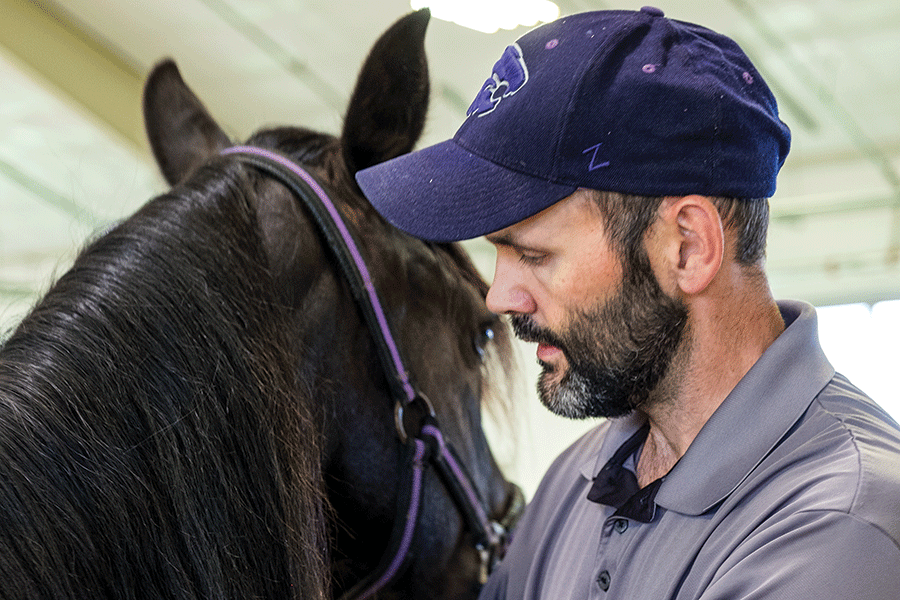
Without looking back at the photos, it’s hard to remember when equine lameness evaluations were completed in the parking lot to the east of Mosier Hall at the Veterinary Health Center. With the addition of the Equine Performance Testing Center (EPTC) in 2017, the possibilities expanded— and so did the caseload for equine surgery and performance medicine.
Since the completion of the EPTC, caseloads for the equine section have increased by approximately 48%.
The advanced facility offers an indoor riding arena with both hard and soft footing, designed to optimally evaluate and diagnose lameness or performance-limiting issues affecting equine patients. The facility also includes an indoor examination area, an imaging suite for radiographs and ultrasound examination, dedicated farrier space and a client consultation room. (ksvhc.org)
Not only has the number of equine patients increased, but so has the variety of cases the clinicians now see. Dr. Dylan Lutter, a board-certified equine surgeon and clinical assistant professor, obtained certification in equine physical therapy and rehabilitation in 2019, and later certification in animal chiropractic, further expanding the services offered.
Dr. Lutter discusses the bone marrow concentrate process with equine surgery resident Dr. Cara Croft.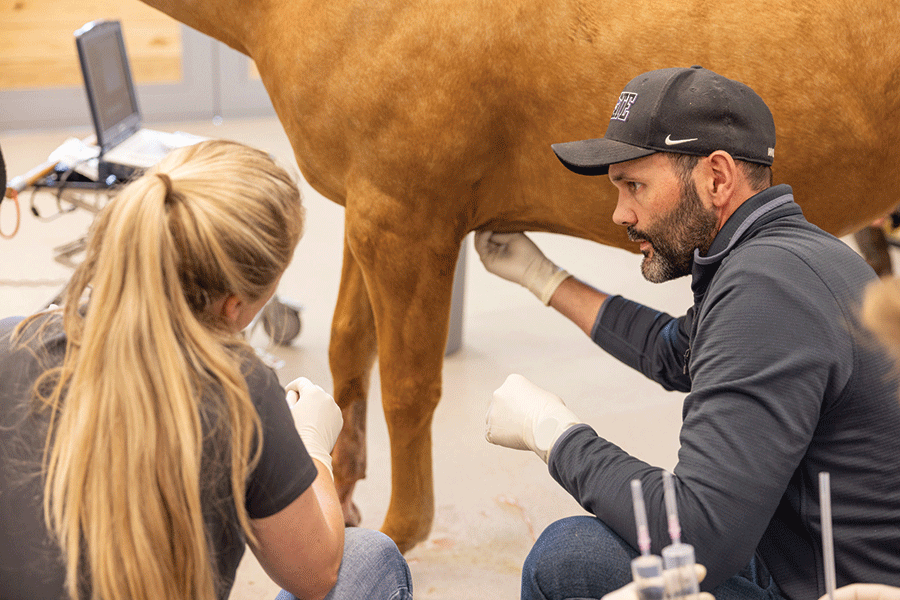
A Recent Case
Cindy Togstad, of Wilber, Nebraska, noticed some head bobbing in Beau, her 9-year-old quarter horse, while her trainer was riding him. They took Beau to a veterinarian, who diagnosed him with navicular disease. Soon after, following recommendations from fellow horse owners, Cindy brought
Beau to the Veterinary Health Center for evaluation by Dr. Lutter in October 2023.
An ultrasound scan revealed that Beau had torn his deep digital flexor tendon and check ligament.
“It happened to be one of the worst tears I’ve ever seen in that particular structure,” Dr. Lutter says. “So we turned right away to Cindy and told her that it was not good news, and that it would be a long road ahead to even get Beau back to where he could comfortably walk.”
After careful consideration and brainstorming, the team decided to proceed with stem cell therapy, an approach
Dr. Lutter had been using at the VHC for some time. Beau’s injuries were injected with stem cells grown from another horse, and he was started on a rehabilitation program.
“Throughout the course of treatment, Beau had some good days and bad days, along with numerous setbacks. He would become more lame, or the tendon would tear,”
Dr. Lutter recalls. “Beau even received a second round of stem cell therapy in the spring and continued on his rehab program. Slowly, but surely — and with Cindy’s hard work and dedication — the tendon began to get stronger.”
Beau started walking more comfortably and was moved from his stall to a larger pen at home. However, by late spring 2024, Dr. Lutter noticed the tendon had become static and wasn’t healing as expected. Despite increased activity, the lesion in the tendon remained unfilled as viewed by ultrasound. In September, the decision was made to try additional therapy to strengthen the tendon further.
Since Beau had already received stem cells twice, he wasn’t a candidate for that treatment again.
“We decided to proceed with bone marrow concentrate, using Beau’s own cells to inject into the injured area in hopes of encouraging healing,” Dr. Lutter says.
A Solid Follow-Up
When Beau returned for a recheck and ultrasound in December, Dr. Lutter found that he still showed mild symptoms of lameness and the dark area from the injury had not filled in completely. However, overall, Beau was moving better.
“Even though Beau isn’t able to return to 100%, and that tendon still has a slight defect, I really think it’s important to consider how much of a success story Beau is,” Dr. Lutter says.
“Without all the therapies we used to treat him, many people would have chosen to euthanize him, as he would have been chronically in pain and unable to even be turned out.”
The rehab journey has been difficult, but Cindy remains positive and speaks highly of her experience.
“They [the VHC team] are top of the line,” she says. “They’re just so awesome and caring. It’s a great facility — and yes, I’ve recommended it to other people. All three of my horses have been here.”
Dr. Lutter performans an ultrasound on Beau's tendon following the bone marrow concentrate process. Also pictured are equine surgery resident Dr. Cara Croft and fourth-year student Yi Wen. 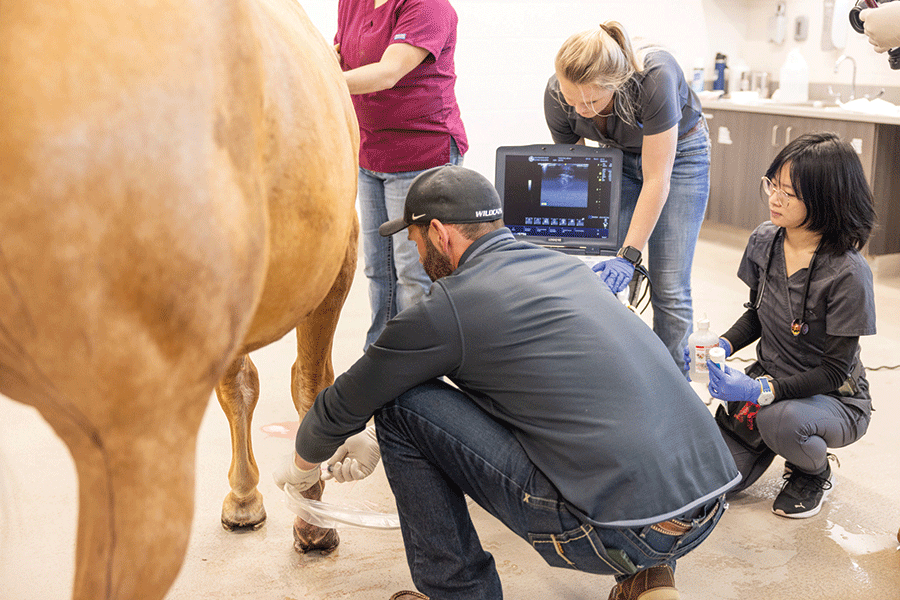
EPTC Enhancement Opportunities
The EPTC has provided exceptional advanced rehabilitation care for horses like Beau. The dedicated space, separate from the main hospital, allows the care team to plan and utilize rehab modalities in an invaluable way, according to Dr. Lutter.
“Having a dedicated facility where we can evaluate patients with either complex subtle lameness or severe injuries like Beau’s has allowed us to focus on cases we didn’t have the capacity for before,” he says.
Although Dr. Lutter and the equine care team were able to provide cutting-edge rehabilitation services in Beau’s case, they faced some challenges with the current capabilities of the EPTC. After treatments at the VHC, Cindy took Beau to an equine therapy facility in Missouri to use a water treadmill to further improve his chances of recovery. If the VHC could add space for a water treadmill and an area where.
Plans for Expansion
Architectural renderings for the proposed expansion of the EPTC. 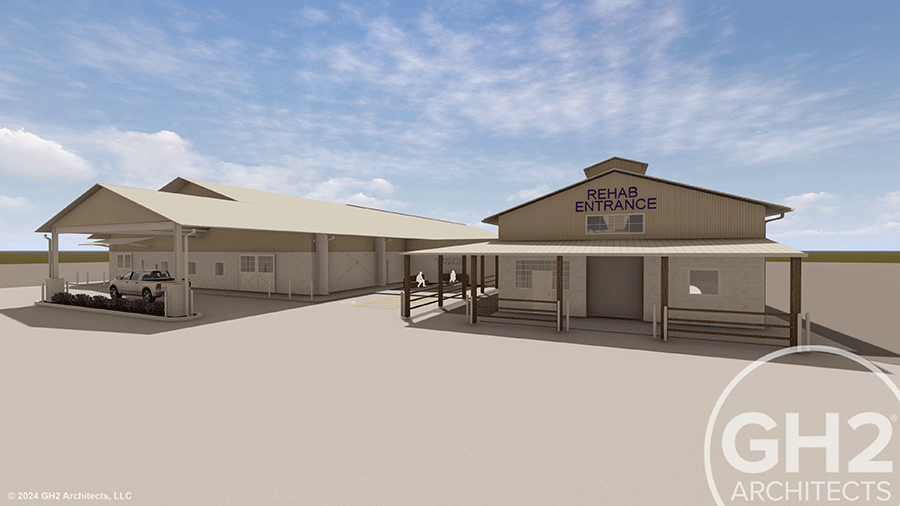

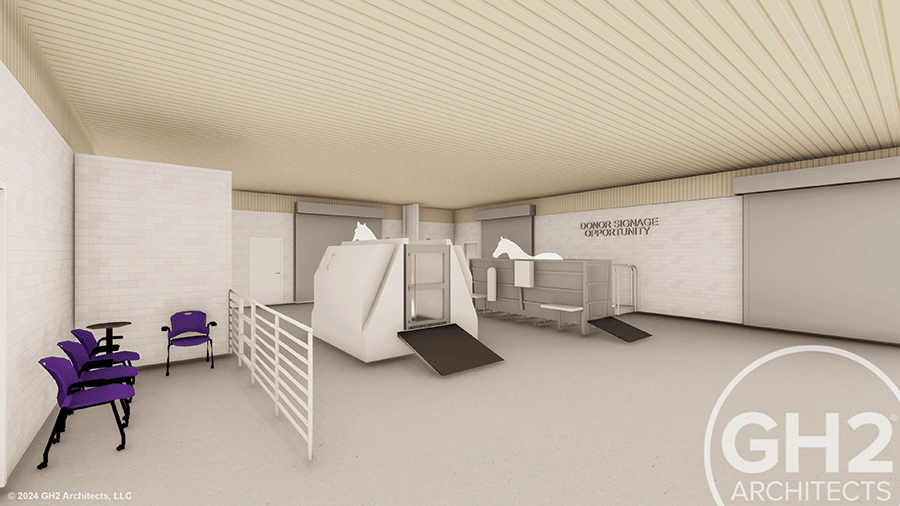
Extra Foot Work
Amanda Bolinger, class of 2026, works on a horse hoof during the equine podiatry class.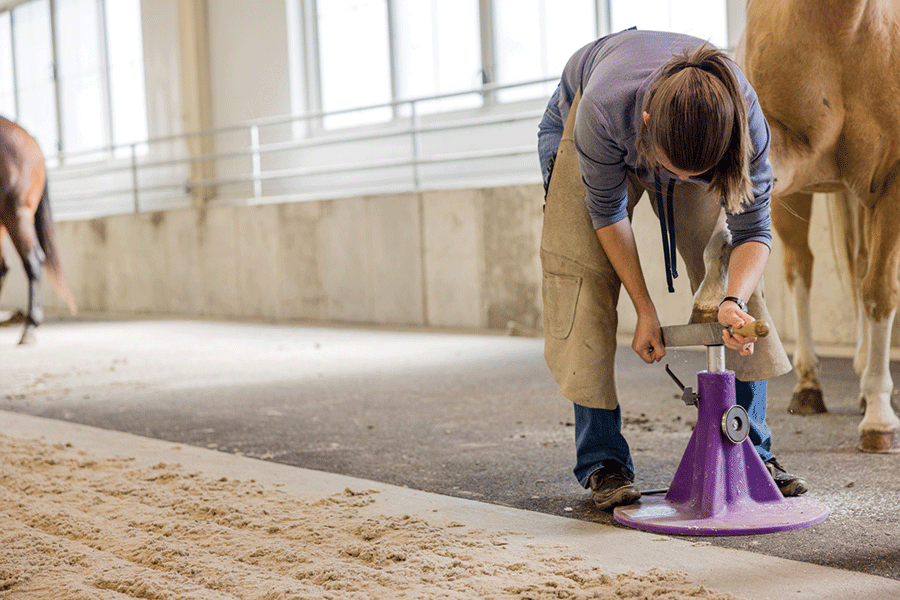
Increased teaching opportunities have also been a key benefit of the EPTC. An equine podiatry class is held every Thursday during the fall semester for third-year veterinary students to learn about horse hoof health. The class was previously taught with Dr. Dylan Lutter by alum Dr. Matt Wimer, DVM class of 2014, who tragically passed away in November.
The EPTC gives students interested in equine hoof health the chance to learn and practice in a dedicated space.
“When we moved the class to the EPTC, it really gave us a calm environment where students could work with horses one-on-one, improving their horsemanship and handling skills,” Dr. Lutter says. “It also allowed us as instructors to move from horse to horse and provide feedback without the distractions of a veterinary hospital environment such as a truck driving by or a barking dog that might startle the horse, which is what happened when we used to work in Mosier Hall.”
Looking to the future, Dr. Lutter believes there are expansion opportunities that could further enhance student education at the EPTC.
“I really think there’s an opportunity to add a dedicated farrier shop and tools, helping veterinary students understand the role a veterinarian plays in making podiatry recommendations and how to work with farriers,” he says.